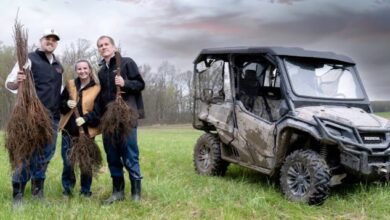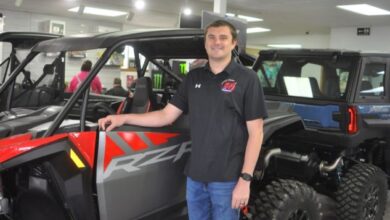The risks and rewards of China – June 5, 2006
Mike Tomberlin, CEO of Tomberlin Outdoor, says it’s not unusual to manufacture a product in China for 20 percent of what it would cost to produce the same item in a more industrialized country.
So it’s no wonder that many powersports manufacturers are obtaining key parts, component groups and finished goods from China. In fact, the amount of powersports and other transportation imports from China has jumped a staggering amount. In 1997, Chinese imports in that category was $327 million. In 2005, it was $1.116 billion — an increase of 241 percent over nine years.
As the manufacturing world grows ever-smaller, sourcing products from halfway around the globe can be nearly as easy as sourcing products domestically.
If cost was the only motivation, nearly everything would be stamped “Made in China” by now. Quality, of course, is vital, and assuring quality often means sending your own people to China to monitor production runs, according to powersports industry sources. The theft of intellectual property is rampant, especially among goods sold in that country, and language barriers can be significant.
But for those willing to invest the time and resources, the payoff can be handsome.
“You have to be smart about what you’re looking for and what can be produced capably and what can’t,” says Peter Hammond, director of Asia Pacific for Polaris Industries Inc., Medina, Minn. Polaris sources several parts, mostly for ATVs, from a handful of Chinese companies, says Hammond.
He’s been working in the region for two decades for Polaris and other companies, and Hammond notes the pace of negotiations has picked up considerably. “If you have a clear purpose and understand partners, within a year you know if it will work or not,” says Hammond, noting that 10 or more years ago, negotiations lasting two or three years were common. But now, Chinese companies are more motivated by profits and likely to wrap up negotiations in a timely fashion.
Unlike Polaris, CMSI Inc. obtains components, other parts and 99 percent of the assembly for its scooters, scooter parts, ATVs and motorcycles from China through a series of joint-venture agreements, says Tom Lynott, president and CEO.
The company is best-known for its Twist N’ Go Scooters, SCOMADI scooters and PM Tuning Racing Products.
Final product assembly and road testing are done once components arrive at CMSI’s Preston, Wash., headquarters. Lynott calls these last two steps “essential if you’re going to control quality and produce products that dealers will be happy with.”
CMSI has three primary joint-venture agreements with Chinese companies that put CMSI staffers in control while the company’s products are being produced. Those workers have the power to hire, fire, discipline and shut production down if necessary. CMSI employs five full-time salaried employees and 300 Chinese workers on a piece-work basis.
Advantages to the Chinese market, Lynott says, include the latest manufacturing technology and robotics, modern communication and transportation systems, companies that are “eager, cooperative and flexible” and a willing partner in the government.
The government wants to promote exports and will help businesses in any way possible, Lynott says. China has the lowest cost structure in the world in terms of raw materials, labor and capital, he added.
EMGO International Ltd. has not sourced parts domestically in a decade, says Emil Gomez, CEO and owner of the Mableton, Ga.-based manufacturer, importer and exporter of motorcycle aftermarket parts and accessories. EMGO sources parts in Taiwan, China, South Korea, Indonesia, Thailand and India.
EMGO gets about 20 percent of its parts from China based on the dollar value of those parts. Just a few years ago, it was just 5 percent based on dollar value, which means that EMGO is shifting more of its business to China. The company buys mainly goggles, soft goods, some handlebars and gun rack sets for ATVs. “Every year, we switch more parts to China,” says Gomez, adding that the company is expanding its operations in China slowly.
“We back our products, so we’re careful in picking manufacturers,” Gomez says. “If a buyer has a problem, he comes to us.”
Gomez travels the world looking for manufacturing partners, checking out factories and meeting with owners. Once a manufacturer has been identified and a price negotiated, EMGO places small orders until it feels comfortable with the quality of the items being produced. Only then does EMGO place an order large enough to justify an international trip to assure product quality before a production run of goods leaves the factory.
Tomberlin Outdoor, which produces ATVs, pitbikes, scooters and go-carts, sources products through contract work with companies in China, Taiwan and South Korea. The company, based in Augusta, Ga., insists on written contracts of up to 40 pages for as many as 10 years and includes significant penalties for quality lapses, says Tomberlin. “The manufacturer has to feel the pain of low quality,” Tomberlin says. “We insist upon it.”
The company uses on-site engineers to ensure quality and clearly detail expectations, says Tomberlin, adding that Mandarin is the preferred language of communication. Although Tomberlin has shifted some production to China under a half-dozen contracts, Taiwan still produces Tomberlin’s youth ATVs.
Those who are sourcing parts or entire vehicles from China are split on whether opportunities remain for others to enter the market. Hammond from Polaris says he’s been hearing for 15 years that if companies don’t invest in China today, the opportunity will be lost.
“I don’t think that’s true at all,” Hammond says. “There are opportunities now, and there will be opportunities in five years.”
Mike Tomberlin, who has been working in China since the late ‘90s, says, “If you’re just starting to source parts from China, you’re behind the curve. Our focus now is selling back into China.” psb




